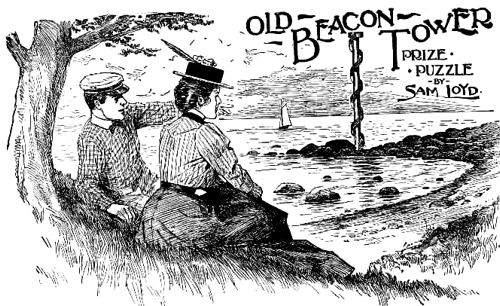



OF COURSE ALL itinerant tourists who have taken their summer outing and wheel along the Jersey coast are familiar with the problem of the old Beacon Tower at Point Lookout, about which there is always such a diversity of opinions at different seasons of the year. The ruins, or speaking more correctly the wreck, of the old tower which served as a lighthouse for more than half a century, stands at present in the last stages of dissolution upon a little ledge of rocks which run out into the sea. The accompanying picture is taken from a sketch made some fifty years ago and furnishes data and information which could only be surmised from the present condition of the tower. The picture, as well as the facts, were obtained from an old resident, now in his ninety-sixth year, and recalls the erection of the tower when he was a very small boy. The entire country turned out to do honor to the event and there were few persons in that neighborhood who did not believe that the old Beacon was just a little bit higher than the tower of Babel.
There is nothing left, now but a charred pole or post some sixty feet high, as the stairs were destroyed by fire twenty odd years ago, but the picture as well as the county records show that it was originally 300 feet high. A very respectable height indeed, when we remember that for over a century the limit of one's powers of conception of height around the city of New York was to say. “As high as Trinity Church steeple,” which just vied with the old Beacon Tower. But the times have changed since that era and it was only the other day that the venerable sexton complained that the naughty boys in the adjoining office building were throwing things down on the church spire.
The center support was composed of huge poles skillfully spiked together, about which there wound a spiral staircase with an iron rail, which went exactly four times around the column, as shown in the sketch. There was one baluster or picket to each step, and as these pickets were just one foot apart, it should really be a very simple matter to determine just how many steps one had to take to reach the top, and yet to quote the words of Captain Huff, who furnished the picture and history of the tower, “I never yet knew one of them city folks who come out here for the summer who could figure it out right.” To the platform of the tower, it was exactly 300 feet high. The stairs circled the column just four times, and as shown in the sketch, was thirty-three feet, ten and a half inches in diameter, from which the circumference can readily be computed, so as to tell how many steps there were.
There were two tricks or pitfalls into which mathematicians and puzzlists fell. It is a simple matter to prove that the length of the hand rail would represent Pythagoras’ line of the hypotenuse of a right- angled triangle. Take a triangular piece of paper and wrap it around a pencil and B to C is the length and A C the hypotenuse

Now, in the Beacon Tower problem the height is 300 feet, and, as the diameter of the circle is 23 feet 10 1/2 inches, which multiplied by 3.1416 would give a circumference of 75 feet, which four times around would also give 300 feet as the length of the base, and the rail would be equal to the length of the line of the hypotenuse, which, however, is the first of the catches, for some of the puzzlists and mathematicians forgot that it takes just as many pickets for the base as it does for the hypotenuse, according to the old puzzle of the pickets of a fence which goes over a hill:

Whether you go from A to Z direct on the level or over the hill there are just 35 pickets, just one foot apart. So in the problem of the Beacon Tower, as four times the circumference would be 300 feet, there would be 300 pickets plus 1 for the top, which is the second point of the problem which so many overlooked, and which makes the correct answer to the puzzle to be 301 pickets or steps.
2. A REBUS.
To meet a need, our maid was sent in
Haste, my whole is what she went in.
Behead, transpose, the thing she bought
Appears, and which she safely brought,
Curtail, transpose, and take for granted
You have the end for which was wanted,
Transpose once more, though strange ’tis true.
The maiden's name appears in view.
3. CHARADE
My first, my second, and my whole.
Are every one the same
In point of meaning, each and all,
An oft repeated name.
Mama.
4.
What is that which the dead and living might do at the same time? Lie.
Why are A and B's successors a ragged lot? Because they are C D.
When does a lady think her husband a Hercules? When he can't get on without his “club.”
When was Napoleon I. most shabbily dressed? When he was out at Elba (elbow).
What professional men generally work with a will? Lawyers.
[Page 132]